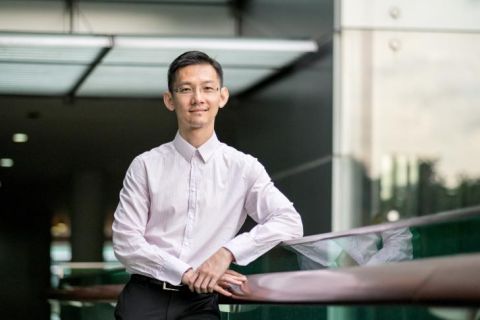
The SMU School of Law has published the most up-to-date picture of Singapore’s fast evolving legal system.

Photo Credit: Shutterstock
By David Turner
SMU Office of Research – The old adage of the more you learn, the more you realise you do not know, might aptly describe the daunted feeling of new law students wading into Singapore’s fast evolving legal system. Like studying the ever-expanding universe, law students must not only grasp a system steeped in tradition and precedents going back to 13th century Great Britain, but also understand the evolution of the burgeoning areas of law that is needed to facilitate 21st century social and commercial worlds.
After seeing first-year law students enter this universe equipped only with outdated textbooks and imaginations fuelled by courtroom television dramas, academics from the Singapore Management University (SMU) School of Law united to create a 360 degree view of Singapore’s legal landscape—the written equivalent of the view from the futuristic disc-shaped Supreme Court overlooking Singapore’s administrative district.
The result was the publication of The Legal System of Singapore - Institutions, Principles and Practices. Edited by two SMU professors: Gary Chan, Associate Professor of Law, and Jack Tsen-Ta Lee, Assistant Professor of Law, the book also contains chapters written by seven other SMU legal academics: Chen Siyuan, Goh Yihan, Gary Low, Mahdev Mohan, Eugene Tan, Tan Seow Hon and Denise Wong. It not only charts the Singapore legal system’s history and evolution, but also guides the students’ minds towards the future.
Developing its own distinctive character
“Singapore’s legal system has evolved and become more sophisticated in a short period of time,” says Professor Chan, who contributed chapters on Singapore’s fast-progressing mediation and arbitration hub, as well as on the more traditional aspects of the Judiciary and case precedents.
He says that giving students clearer pathways into Singapore’s system frees up their mental space to delve into particular areas more deeply. “The law has many sub-divisions with a life of their own—for example complex crimes, commercial crimes and new institutions such as Singapore’s recently established International Commercial Court.”
Editing the book gave Professor Chan a bird’s eye view of the unique ways in which Singapore’s legal system has developed. “If you look at the common thread throughout the development of Singapore’s legal system, it has had a very pragmatic focus,” he explains, citing the willingness of the Government to make incremental improvements.
The Judiciary itself has promoted improvement and evolution to ensure that the legal system focuses on achieving better outcomes for the community, he shares. This is reflected in the development of less adversarial systems with a stronger focus on the people involved, such as in Singapore’s mediation and arbitration system, which sprang in part from the Judiciary’s strong support. “Since the early 1990s, through their judgments, they have strongly supported arbitration and mediation to resolve disputes in the best possible manner,” Professor Chan notes.
Other innovations to better support communities include the establishment of community courts and reform of the family courts. “Instead of drawing family problems or community disputes into an adversarial system, they focus on the needs of children and of the community,” he stresses, adding that community courts allow for more gradated responses to offences by juveniles.
The book also has a chapter written by Assistant Professor Gary Low that explains the tensions between the domestic needs of Singapore’s legal system and the need to open up the profession to facilitate global business, creating what the book terms as a “glocalised legal profession”, with certain segments carved out for participation by foreign law firms.
How far can the court go?
As well as charting the legal system’s development, the book seeks to help students foresee or even shape the future direction of Singapore’s constitution and judicial systems. In developing his chapter, “Fundamental Constitutional Concepts and the Roles of the Branches of Government”, Professor Lee felt it was important for law students to understand that, even when speaking of fundamental institutions, there is no single right answer about what role each body should play.
“The idea of what the courts should do is contested,” says Professor Lee, referring to the system of checks and balances between the legislature, the judiciary and the executive. He cites recent cases in which the courts have remained reluctant to review government decisions, holding the view that the issues involved were political and so should be dealt with by the Government or Parliament. “The courts see their supervisory role as generally limited to overruling Government decisions that lead to plainly absurd outcomes.”
While Professor Lee emphasises the legitimacy of this view of the courts’ role, he hopes to draw students’ attention to other views that the courts could perform a more robust role in supervising the Government’s compliance with constitutional principles. “The important thing is for students to understand that there is more than one view about the role that courts can play.”
Understanding these contested ideas is becoming increasingly important as the public appears to be applying to the courts to review government decisions more often. “In the Internet age, people are more inspired and emboldened to assert that they have rights and to try to claim them through the courts,” says Professor Lee.
His chapter canvasses the arguments against more activist courts, including the key argument that, unlike members of parliament, judges are appointed rather than elected, suggesting they should steer clear of decisions that would create new policy. Yet, Professor Lee is not persuaded by this view. “Taken to an extreme, this would mean judges should never overrule government decisions, but clearly our system of judicial review envisages that the courts have a duty to do so when the government has acted outside of the Constitution,” he argues.
An evolving constitution with no precedent
Even with fewer challenges to government decisions than other jurisdictions, where such challenges help to drive constitutional developments, Singapore’s Constitution continues to evolve. Professor Lee notes that Parliament has actively amended and tweaked the legal system, such as through the introduction of nominated and non-constituency members of parliament and the elected presidency.
The limited volume of administrative and constitutional case law creates other challenges, in particular for legal academics seeking to elucidate the principles and practices of Singapore’s system of public law. Without such cases, significant principles developed elsewhere remain untested in Singapore, says Professor Lee. “Students in Singapore are still using British administrative law textbooks, and the lack of case law means we need to speculate to some extent during the course I teach.”
He cites the principle known as ‘substantive legitimate expectation’ under which a government cannot go back on a representation that something will be done, when it has been relied on by the party to whom the representation was made. “Although this principle was confirmed to exist in the UK more than a decade ago, the Singapore High Court only followed suit in 2013. However, we still don’t know if the Court of Appeal will confirm the existence of the principle as the matter was settled before it went up on appeal,” he adds.
This and other challenges will no doubt face law students when they enter the legal universe. Cases that challenge and test the grey areas of the Constitution are increasing, with recent constitutional cases covering issues such as rules restricting religious processions and the government’s obligation to call by-elections.
Steering the book as co-editor and reviewing the system has left Professor Chan with a positive view on the ability of the legal system to evolve in a beneficial manner. “Overall, the legal system has improved on several fronts and this includes the legal institutions: the Judiciary, Parliament and the Attorney-General’s Chambers.” He is also confident in the next generation’s ability to negotiate the paths ahead. “Our students are bright, hard-working and willing to share their views.”
|
The Legal System of Singapore - Institutions, Principles and Practices: Table of contents: 1. History of the Singapore Legal System – Goh Yihan |
See More News
Want to see more of SMU Research?
Sign up for Research@SMU e-newslettter to know more about our research and research-related events!
If you would like to remove yourself from all our mailing list, please visit https://eservices.smu.edu.sg/internet/DNC/Default.aspx

